California is bearing witness to the devastating impacts of climate change. In 2020 alone, wildfires of historic size, scale, and scope swept across our state. Lives were lost; homes and businesses were destroyed; and nature we treasure is gone. These fires took place in the middle of a deadly pandemic and heatwave, and on the heels of a prolonged drought.
The Natural Resources Agency is committed to doubling down on our climate action through policies, programs, and partnerships that also increase equity, improve public health, and create economic opportunity. You can read more about our partnerships, programs, tools and resources below.
We are currently partnering with sister agencies and stakeholders to drive on and implement:
- Scoping Plan
- Natural and Working Lands Climate Smart Strategy; For more information about this initiative visit our webpage, Expanding Nature-Based Solutions.
- 30x30 Strategic Pathways Document; For more information about this initiative visit California Nature
Climate Action
The Natural Resources Agency is statutorily required to release a state strategy to build climate resilience every three years (AB 1482, Gordon, 2015). More information on the 2024 Update coming soon, please check back!
Learn more about the 2021 State Adaptation Strategy
Review Past State Adaptation Strategy Documents
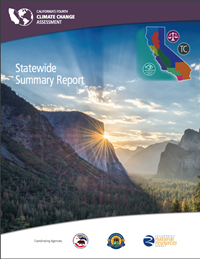 Since 2006, the State has undertaken four comprehensive climate change assessments. These assessments provide a state-of-play on the best available climate change science, and inform the updates to the State’s Adaptation Strategy and the state’s actions to build climate resilience.
Since 2006, the State has undertaken four comprehensive climate change assessments. These assessments provide a state-of-play on the best available climate change science, and inform the updates to the State’s Adaptation Strategy and the state’s actions to build climate resilience.
- What communities will be hardest hit by sea level rise?
- What does increased likelihood of drought mean for food production?
- What are the implications of decreased snowpack on water supply?
- When and where will temperatures rise to the level of creating a public health concern?
Assessments help us understand what climate change means for our future, and empower us to plan accordingly. California’s most recent assessment provided regionally specific and actionable climate science, which has supported decisionmakers across the state. California’s climate change assessments were codified in SB 1320, and the Natural Resources Agency is excited to partner with sister agencies to continue California’s legacy of science-based climate action. To learn more about California’s Fifth Climate Change Assessment, which is currently underway, click here
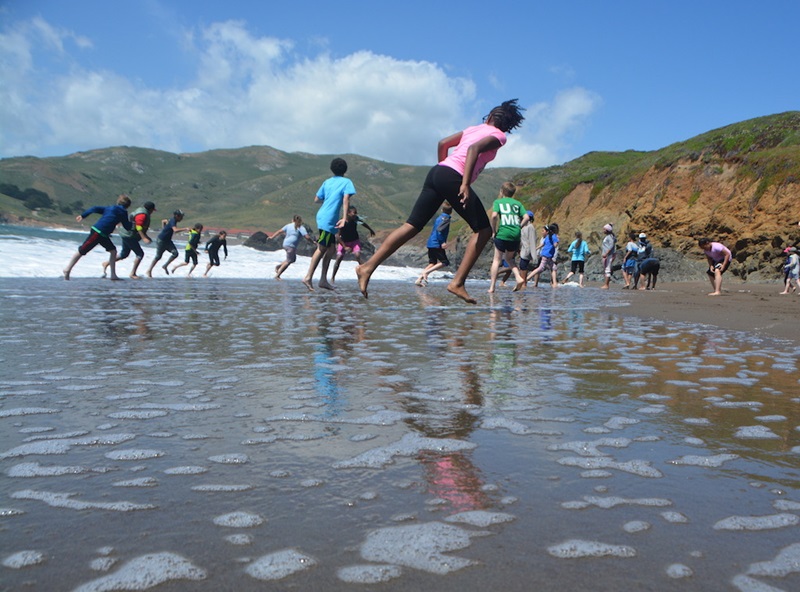
California is driving on a number of strategic plans to achieve our climate change goals. Many of these strategies are developed and implemented by entities within the Natural Resources Agency. These plans inform policy makers and prioritize funding for grants, projects, and programs. Examples include:
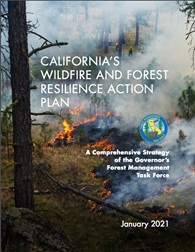 California's Wildfire and Forest Resilience Action Plan (2021):The Wildfire and Forest Resilience Action Plan is designed to strategically accelerate efforts to: restore the health and resilience of California forests, grasslands and natural places; improve the fire safety of our communities; and sustain the economic vitality of rural forested areas. This Action Plan will serve as a roadmap for implementing the Agreement for Shared Stewardship of California’s Forest and Rangelands with the United States Forest Service, and for aligning the state’s efforts with other federal, local, tribal, regional and private organizations.
California's Wildfire and Forest Resilience Action Plan (2021):The Wildfire and Forest Resilience Action Plan is designed to strategically accelerate efforts to: restore the health and resilience of California forests, grasslands and natural places; improve the fire safety of our communities; and sustain the economic vitality of rural forested areas. This Action Plan will serve as a roadmap for implementing the Agreement for Shared Stewardship of California’s Forest and Rangelands with the United States Forest Service, and for aligning the state’s efforts with other federal, local, tribal, regional and private organizations.
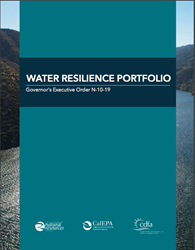 California Water Resilience Portfolio (2020): Water is central to nearly everything we value in California. Healthy communities, economies, farms, ecosystems and cultural traditions depend on steady supplies of safe and affordable water. Those values are increasingly at risk as California confronts more extreme droughts and floods, rising temperatures, overdrafted groundwater basins, aging infrastructure and other challenges magnified by climate change. For some of California's most vulnerable populations, the risks are particularly acute. The Water Resilience Portfolio was developed to improve California's capacity to prepare for disruptions, withstand and recover from climate-related shocks, and adapt into the future.
California Water Resilience Portfolio (2020): Water is central to nearly everything we value in California. Healthy communities, economies, farms, ecosystems and cultural traditions depend on steady supplies of safe and affordable water. Those values are increasingly at risk as California confronts more extreme droughts and floods, rising temperatures, overdrafted groundwater basins, aging infrastructure and other challenges magnified by climate change. For some of California's most vulnerable populations, the risks are particularly acute. The Water Resilience Portfolio was developed to improve California's capacity to prepare for disruptions, withstand and recover from climate-related shocks, and adapt into the future.
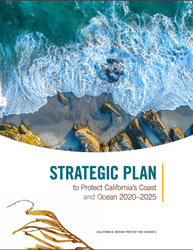 Ocean Protection Council's Strategic Plan to Protect California's Coast and Ocean 2020-2025 (2020): OPC's Strategic Plan to Protect California's Coast and Ocean 2020-2025 recognizes the threats that climate change poses to the State's coastal and ocean ecosystems and provides a roadmap for protecting and adapting these resources in the face of sea-level rise, ocean acidification and hypoxia, ocean warming, and other climate-driven stressors. The Strategic Plan also prioritizes understanding the role of California’s network of marine protected areas in providing ecosystem resilience to climate change and ensuring fisheries and fishing communities can adapt and thrive in changing ocean conditions.
Ocean Protection Council's Strategic Plan to Protect California's Coast and Ocean 2020-2025 (2020): OPC's Strategic Plan to Protect California's Coast and Ocean 2020-2025 recognizes the threats that climate change poses to the State's coastal and ocean ecosystems and provides a roadmap for protecting and adapting these resources in the face of sea-level rise, ocean acidification and hypoxia, ocean warming, and other climate-driven stressors. The Strategic Plan also prioritizes understanding the role of California’s network of marine protected areas in providing ecosystem resilience to climate change and ensuring fisheries and fishing communities can adapt and thrive in changing ocean conditions.
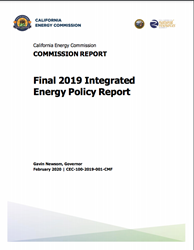 Integrated Energy Policy Report (2019): California is working to make sweeping changes in its energy system to address climate change, improve air quality, and make sure that all Californians share in the benefits of the state's clean energy future. The IEPR assesses a variety of energy trends and issues to inform our decision-making as we work to create an energy system that is clean, modern, and safe, while increasing its resiliency to climate change and improving the equity of how clean energy benefits are realized.
Integrated Energy Policy Report (2019): California is working to make sweeping changes in its energy system to address climate change, improve air quality, and make sure that all Californians share in the benefits of the state's clean energy future. The IEPR assesses a variety of energy trends and issues to inform our decision-making as we work to create an energy system that is clean, modern, and safe, while increasing its resiliency to climate change and improving the equity of how clean energy benefits are realized.
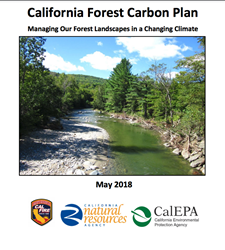 California Forest Carbon Plan (2018): Our state is blessed with 33 million acres of forestland and an urban forest canopy that together capture and clean our water supply, provide habitat for countless wildlife, cool our cities, support local economies, and serve as spiritual and cultural centers for indigenous and local communities across the state. Forested lands also are the largest land-based carbon sink. This plan lays out recommended actions to achieve healthy and resilient forests based on what we know today about our forests and how climate change will evolve in California.
California Forest Carbon Plan (2018): Our state is blessed with 33 million acres of forestland and an urban forest canopy that together capture and clean our water supply, provide habitat for countless wildlife, cool our cities, support local economies, and serve as spiritual and cultural centers for indigenous and local communities across the state. Forested lands also are the largest land-based carbon sink. This plan lays out recommended actions to achieve healthy and resilient forests based on what we know today about our forests and how climate change will evolve in California.
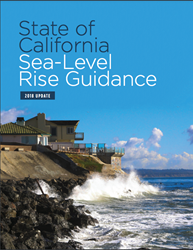 California Sea-Level Rise Guidance (2018): OPC, in coordination with coastal and ocean state agencies and the Governor's Office of Planning Research, leads the development of the State's Sea-Level Rise Guidance Policy and subsequent updates every five years. The Guidance is used by California's coastal zone management agencies to support planning and permitting activities. The 2018 update incorporated advances in ice loss science and projections of sea-level rise and includes guidance to address the needs of both state agencies and local governments.
California Sea-Level Rise Guidance (2018): OPC, in coordination with coastal and ocean state agencies and the Governor's Office of Planning Research, leads the development of the State's Sea-Level Rise Guidance Policy and subsequent updates every five years. The Guidance is used by California's coastal zone management agencies to support planning and permitting activities. The 2018 update incorporated advances in ice loss science and projections of sea-level rise and includes guidance to address the needs of both state agencies and local governments.
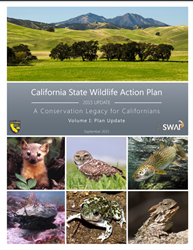 State Wildlife Action Plan (2015):The State Wildlife Action Plan examines the health of wildlife and prescribes actions to conserve wildlife and vital habitat before they become more rare and more costly to protect. The plan also promotes wildlife conservation while furthering responsible development and addressing the needs of a growing human population. In the latest update of the State Wildlife Action Plan, the California Department of Fish and Wildlife incorporated climate change impacts and adaptation, including dozens of strategies and targets for California's ecoregions.
State Wildlife Action Plan (2015):The State Wildlife Action Plan examines the health of wildlife and prescribes actions to conserve wildlife and vital habitat before they become more rare and more costly to protect. The plan also promotes wildlife conservation while furthering responsible development and addressing the needs of a growing human population. In the latest update of the State Wildlife Action Plan, the California Department of Fish and Wildlife incorporated climate change impacts and adaptation, including dozens of strategies and targets for California's ecoregions.
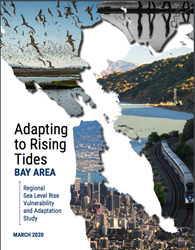 Adapting to Rising Tides (ART) Program (continuous): the San Francisco Bay Conservation and Development Commission works with stakeholders around the Bay Area to understand their vulnerability to sea level rise and how future flooding will communities, businesses, infrastructure, and natural systems. Since 2011, the ART Program has conducted research and provided tools, guidance, and information to local cities and counties to help support complex decision-making around climate adaptation. ART has conducted projects at the regional, local, and sectoral scales.
Adapting to Rising Tides (ART) Program (continuous): the San Francisco Bay Conservation and Development Commission works with stakeholders around the Bay Area to understand their vulnerability to sea level rise and how future flooding will communities, businesses, infrastructure, and natural systems. Since 2011, the ART Program has conducted research and provided tools, guidance, and information to local cities and counties to help support complex decision-making around climate adaptation. ART has conducted projects at the regional, local, and sectoral scales.
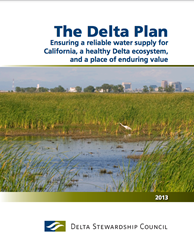 Delta Adapts - Creating a Climate Resilient Future (forthcoming): California relies on the Sacramento-San Joaquin Delta in many ways. It supplies a portion of the drinking water for 27 million Californians, fuels California's $3 trillion economy, and is a biodiversity hotspot for more than 750 plant and animal species. Changes in climate put the state's water supply, economy, and biodiversity at risk—decreasing water quality and increasing stress on levees that protect residents, farmland, and the state's network of public utilities from mass flooding, and the species who thrive in the region's ecosystems. The Delta Stewardship Council working with partners to undertake a regional vulnerability assessment, and develop a regional climate adaptation plan.
Delta Adapts - Creating a Climate Resilient Future (forthcoming): California relies on the Sacramento-San Joaquin Delta in many ways. It supplies a portion of the drinking water for 27 million Californians, fuels California's $3 trillion economy, and is a biodiversity hotspot for more than 750 plant and animal species. Changes in climate put the state's water supply, economy, and biodiversity at risk—decreasing water quality and increasing stress on levees that protect residents, farmland, and the state's network of public utilities from mass flooding, and the species who thrive in the region's ecosystems. The Delta Stewardship Council working with partners to undertake a regional vulnerability assessment, and develop a regional climate adaptation plan.
The Resources Agency contributes to California's climate action through programs that reduce greenhouse gas emissions, sequester carbon, and build resilience to the impacts of climate change. Examples include:
Forests and Wildfire
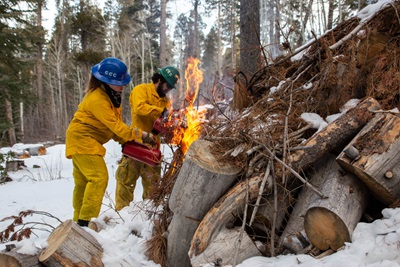 CAL FIRE's Climate Change Program: CAL FIRE is working at local, state and national levels to protect and manage California forests so they can return to carbon sinks and increase California’s resilience to wildfires. CAL FIRE has identified five forestry strategies for reducing or mitigating greenhouse gas emissions, including: reforestation, forestland conservation, fuels reduction, urban forestry, and improved management.
CAL FIRE's Climate Change Program: CAL FIRE is working at local, state and national levels to protect and manage California forests so they can return to carbon sinks and increase California’s resilience to wildfires. CAL FIRE has identified five forestry strategies for reducing or mitigating greenhouse gas emissions, including: reforestation, forestland conservation, fuels reduction, urban forestry, and improved management.
Urban and Community Forestry Grant Program: Through the Urban and Community Forestry Grant Program, CAL FIRE works to optimize the benefits of trees and related vegetation through multiple‐objective projects. The mission of the program is to lead the effort to advance the development of sustainable urban and community forests in California. Trees provide energy conservation, reduction of storm‐water runoff, extend the life of surface streets, improve local air, soil, and water quality, reduce atmospheric carbon dioxide, improve public health, provide wildlife habitat, and increase property values.
Urban Greening Grant Program: CNRA's Urban Greening Grant Program funds projects that reduce greenhouse gas emissions by sequestering carbon, decreasing energy consumption, and reducing vehicle miles traveled, while also transforming the built environment into places that are more sustainable, enjoyable, and effective in creating healthy and vibrant communities.
Department of Conservation Climate Change Initiatives: The Department of Conservation administers several programs that drive on climate change, including the Regional Forest and Fire Capacity Program, which seeks to increase regional capacity to prioritize, develop, and implement projects that improve forest health and fire resilience, facilitate greenhouse gas emissions reductions, and increase carbon sequestration in forests throughout California.
California Conservation Corps' Targeted Conservation Programs and Grant Programs: Under its Targeted Conservation Program, the California Conservation Corps (CCC) operates three programs dedicated to forest health and resiliency. Through these programs, corpsmembers reduce overgrown and dying trees, plant trees, and build fire breaks. The CCC also operates the Watershed Stewards Program, whose mission is to conserve, restore, and enhance anadromous watersheds. Moreover, CCC administers several programs and grants to conserve, restore and enhance California's natural resources, including watershed protection and wildland fire prevention projects.
California Tahoe Conservancy's Climate Change Adaptation Program: The California Tahoe Conservancy's strategic plan includes a goal to foster Basin-wide climate change adaptation and sustainable communities. To achieve this goal, the Conservancy focuses on four areas: developing the Lake Tahoe Climate Adaptation Action Portfolio (CAAP), providing grants to support climate change adaptation, adapting Conservancy programs and land management to changing climate conditions, and engaging partners and collaborating with scientists.
Water
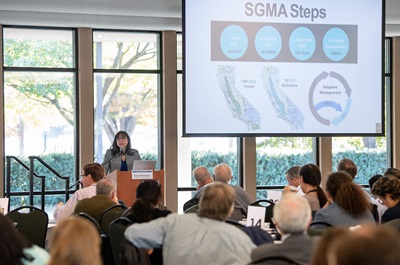 Sierra Nevada Conservancy's Watershed Improvement Program: The Sierra Nevada Conservancy's Watershed Improvement Program is a large-scale restoration program designed to restore the health of California's primary watershed and create resilient Sierra Nevada communities. It is recognized by state policy and planning documents as a model program for addressing the growing challenges facing the Sierra Nevada Region in a changing climate.
Sierra Nevada Conservancy's Watershed Improvement Program: The Sierra Nevada Conservancy's Watershed Improvement Program is a large-scale restoration program designed to restore the health of California's primary watershed and create resilient Sierra Nevada communities. It is recognized by state policy and planning documents as a model program for addressing the growing challenges facing the Sierra Nevada Region in a changing climate.
Department of Water Resource's Climate Change Program: The Department of Water Resources (DWR)'s climate change program performs a range of activities to support climate change analysis and adaptation planning by local and regional water managers, fund climate monitoring and research, and develop water sector policies and management practices. DWR is also developing its own comprehensive Climate Action Plan (CAP).
Department of Conservation Climate Change Initiatives: The Department of Conservation administers several programs that drive on climate change, including The Watershed Coordinator Program which enables local governments or non-profits to develop plans and projects to improve watershed health, to achieve targeted state and local natural resources climate resiliency goals including forest health and groundwater sustainability.
Urban Flood Protection Grant Program: CNRA's Urban Flood Protection Grant Program funds multibenefit projects in urbanized areas to address flooding. Projects include stormwater capture and reuse, planning and implementation of low impact development, restoration of urban streams and watersheds, and increasing permeable surfaces to help reduce flooding.
Oceans and Coasts
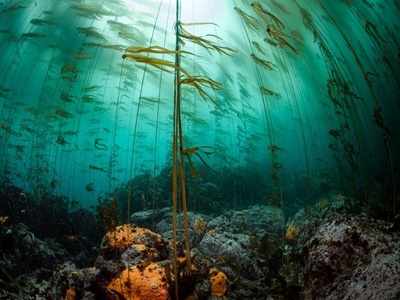 The Ocean Protection Council’s Climate Change Program: OPC's Climate Change Program seeks to prepare for and reduce harmful impacts of climate change on ocean and coastal resources by encouraging adaptation and mitigation, and engaging decision makers at all levels of government. OPC is a leader in helping the State address the impacts of sea-level rise and ocean acidification through advancing science, monitoring change, developing adaptation strategies and policy guidance, and engaging in national and international partnerships.
The Ocean Protection Council’s Climate Change Program: OPC's Climate Change Program seeks to prepare for and reduce harmful impacts of climate change on ocean and coastal resources by encouraging adaptation and mitigation, and engaging decision makers at all levels of government. OPC is a leader in helping the State address the impacts of sea-level rise and ocean acidification through advancing science, monitoring change, developing adaptation strategies and policy guidance, and engaging in national and international partnerships.
California Coastal Commission's Climate Change Program: The Commission considers climate change through its planning, regulatory, and educational activities, and works to reduce greenhouse gas emissions and the detrimental impacts of global warming on the California coast. Through its Sea Level Rise Policy Guidance, the Coastal Commission advances, supports, and helps to fund California's preparation for these critical challenges to ensure a resilient coast.
California State Lands Commission's Efforts to Address Sea Level Rise: The State Lands Commission facilitates sea level rise preparedness, with an emphasis on protecting California's public trust lands and the public's right to access and enjoy these lands. AB 691 (Muratsuchi) Chapter 592, Statutes of 2013, involves sea level rise impacts on granted public trust lands. Specifically, larger trustees are required to prepare and submit an assessment of how they propose to address sea level rise to the Commission.
California State Coastal Conservancy's Climate Change Initiatives: The Coastal Conservancy's Climate Ready Program is helping natural resources and human communities along California's coast and San Francisco Bay adapt to the impacts of climate change. The Conservancy is also working to capture greenhouse gases from the atmosphere through the conservation of natural and working lands. Additionally, the Conservancy adopted a Climate Change Policy that informs all aspects of its work and amended its Project Selection Criteria to ensure that all Conservancy projects are designed with climate change in mind.
San Francisco Bay Conservation and Development Commission's Climate Change Initiatives: The San Francisco Bay Conservation and Development Commission (BCDC) facilitates resilience through its permitting program, which requires developments to address sea level rise impacts in their design. Additionally, BCDC's Adapting to Rising Tides (ART) Program provides support, guidance, tools, and information to help agencies and organizations address sea level rise.
Sacramento-San Joaquin Delta Conservancy Carbon Management Program: The Delta Conservancy incentivizes landowners to convert to practices that reduce carbon emissions and land subsidence that result from oxidation of highly organic peat soils in the Delta. A voluntary market protocol was approved by the American Carbon Registry in 2017 for restoration of coastal and deltaic wetlands in California. In 2020, the program completed the first verification and certification of wetland carbon credits anywhere in the world.
Biodiversity
 California Biodiversity Collaborative: The California Biodiversity Collaborative is a powerful new platform to enable active stewardship of our state’s biodiversity. Calling on broad participation from across California, the Collaborative provides a forum to coordinate public and private programs and investments; to share information and build on best practices; to facilitate partnerships and increase understanding; to draw from the best of what our state has to offer. It will help us build a unified, comprehensive approach to preserving our biodiversity and spur important actions to meet this imperative.
California Biodiversity Collaborative: The California Biodiversity Collaborative is a powerful new platform to enable active stewardship of our state’s biodiversity. Calling on broad participation from across California, the Collaborative provides a forum to coordinate public and private programs and investments; to share information and build on best practices; to facilitate partnerships and increase understanding; to draw from the best of what our state has to offer. It will help us build a unified, comprehensive approach to preserving our biodiversity and spur important actions to meet this imperative.
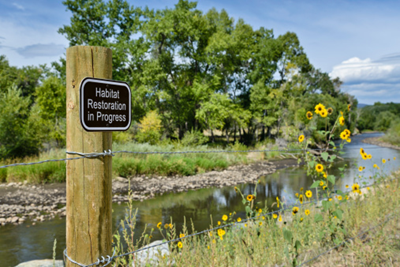 California Department of Fish and Wildlife's Climate Change Initiatives: The California Department of Fish and Wildlife's (CDFW) Science Institute's Climate Change Program evaluates climate risks to biodiversity and supports integration of climate science and adaptation into the Department's programs and activities. The Department is actively addressing climate change in species and habitat management, land management, conservation planning, and scientific endeavors. CDFW's Wetland Restoration for Greenhouse Gas Reduction Program directly addresses both climate change adaptation and mitigation by restoring or enhancing wetlands and watershed ecosystems.
California Department of Fish and Wildlife's Climate Change Initiatives: The California Department of Fish and Wildlife's (CDFW) Science Institute's Climate Change Program evaluates climate risks to biodiversity and supports integration of climate science and adaptation into the Department's programs and activities. The Department is actively addressing climate change in species and habitat management, land management, conservation planning, and scientific endeavors. CDFW's Wetland Restoration for Greenhouse Gas Reduction Program directly addresses both climate change adaptation and mitigation by restoring or enhancing wetlands and watershed ecosystems.
Wildlife Conservation Board's Climate Adaptation and Resiliency Program: This program funds projects that provide climate adaptation and resilience on California's natural and working lands. These projects must be consistent with the State's climate adaptation strategy, contribute to the goals of AB 32, support WCB's Strategic Plan, and help fulfil WCB's Mission to protect, restore, and enhance California's spectacular natural resources for wildlife and for the public's use and enjoyment.
Energy
California Energy Commission's Climate Change Initiatives: The California Energy Commission manages numerous programs and efforts that help California meet its climate goals by increasing energy efficiency and conservation, as well as advancing renewable energy and low carbon technologies.
California Geologic Energy Management Division's Carbon Capture and Sequestration Program: The California Geologic Energy Management Division (CalGEM), within the California Department of Conservation, prioritizes protecting public health, safety, and the environment in its oversight of the oil, natural gas, and geothermal industries, while working to help California achieve its climate change and clean energy goals. CalGEM facilitates the State's Carbon Capture and Sequestration (CCS) Program, which involves the capture, transport, and long-term storage of carbon dioxide in geological reservoirs deep underground that would otherwise be released to the atmosphere.
Land Conservation
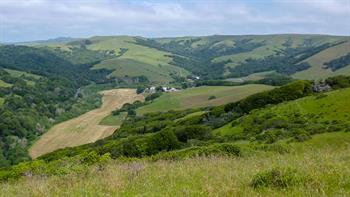 Department of Conservation Climate Change Initiatives: The Department of Conservation administers several programs that drive on climate change, including: the Sustainable Agricultural Lands Conservation (SALC) Program, which facilitates the purchase of agricultural conservation easements, development of agricultural land strategy plans, and other mechanisms that result in greenhouse gas reductions and a more resilient agricultural sector; and the Working Lands and Riparian Corridors Program, which funds watershed restoration projects and conservation projects on agricultural lands.
Department of Conservation Climate Change Initiatives: The Department of Conservation administers several programs that drive on climate change, including: the Sustainable Agricultural Lands Conservation (SALC) Program, which facilitates the purchase of agricultural conservation easements, development of agricultural land strategy plans, and other mechanisms that result in greenhouse gas reductions and a more resilient agricultural sector; and the Working Lands and Riparian Corridors Program, which funds watershed restoration projects and conservation projects on agricultural lands.
California is cultivating partnerships at the national and international levels to advance bold action on climate change. A few examples of our collaboration include:
International
 United Nations Convention on Biological Diversity: In December 2020, Secretary Crowfoot announced the California Natural Resources Agency will participate in the UN discussions on biodiversity as a subnational observer. We will work with partners around the world to deliver solutions to global biodiversity and climate crises.
United Nations Convention on Biological Diversity: In December 2020, Secretary Crowfoot announced the California Natural Resources Agency will participate in the UN discussions on biodiversity as a subnational observer. We will work with partners around the world to deliver solutions to global biodiversity and climate crises.
 Under2 Coalition: This coalition represents a global community of state and regional governments committed to ambitious climate action in line with the Paris Agreement. Including California, the coalition brings together more than 220 governments who represent over 1.3 billion people and 43% of the global economy. Signatories commit to keeping global temperature rises to well below 2°C with efforts to reach 1.5°C.
Under2 Coalition: This coalition represents a global community of state and regional governments committed to ambitious climate action in line with the Paris Agreement. Including California, the coalition brings together more than 220 governments who represent over 1.3 billion people and 43% of the global economy. Signatories commit to keeping global temperature rises to well below 2°C with efforts to reach 1.5°C.
 Pacific Coast Collaborative: In 2013, California, Oregon, Washington, and British Columbia set the Pacific Coast Collaborative (PCC) on its current course of ambitious climate and clean energy policy by signing the Pacific Coast Action Plan on Climate and Energy, which was updated three years later as the Pacific Coast Climate Leadership Action Plan. At the Global Climate Action Summit in 2018, the PCC states released a declaration on climate resilience and are now working to develop a climate resilience framework. Additionally, PCC members are engaged in the Pacific Coast Forestry MOU to better understand forest carbon dynamics and how forests are responding to climate change.
Pacific Coast Collaborative: In 2013, California, Oregon, Washington, and British Columbia set the Pacific Coast Collaborative (PCC) on its current course of ambitious climate and clean energy policy by signing the Pacific Coast Action Plan on Climate and Energy, which was updated three years later as the Pacific Coast Climate Leadership Action Plan. At the Global Climate Action Summit in 2018, the PCC states released a declaration on climate resilience and are now working to develop a climate resilience framework. Additionally, PCC members are engaged in the Pacific Coast Forestry MOU to better understand forest carbon dynamics and how forests are responding to climate change.
 International Alliance to Combat Ocean Acidification: California is one of the founding members of the International Alliance to Combat Ocean Acidification (OA Alliance). The OA Alliance brings together nations, subnational entities, tribes, first nations, and non-governmental entities to jointly address ocean acidification. Mechanisms include the development of jurisdictional action plans, efforts to increase awareness of ocean acidification, and concomitant funding commitments.
International Alliance to Combat Ocean Acidification: California is one of the founding members of the International Alliance to Combat Ocean Acidification (OA Alliance). The OA Alliance brings together nations, subnational entities, tribes, first nations, and non-governmental entities to jointly address ocean acidification. Mechanisms include the development of jurisdictional action plans, efforts to increase awareness of ocean acidification, and concomitant funding commitments.
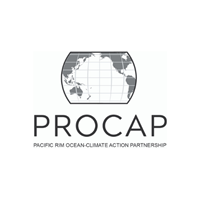 Pacific Rim Ocean-Climate Action Partnership: Pacific leaders are working together in the face of climate change to protect the Pacific and the billions of people who rely on its health. The Pacific Rim Ocean-Climate Action Partnership (PROCAP) is a voluntary initiative of non-state and state actors. The members of this national-subnational partnership will resolve to drive ambitious reductions in greenhouse gas emissions, maximize sustainable ocean-related mitigation measures, and build the climate resilience of ocean and coastal ecosystems as well as the communities and economies on the front lines of ocean and climate change.
Pacific Rim Ocean-Climate Action Partnership: Pacific leaders are working together in the face of climate change to protect the Pacific and the billions of people who rely on its health. The Pacific Rim Ocean-Climate Action Partnership (PROCAP) is a voluntary initiative of non-state and state actors. The members of this national-subnational partnership will resolve to drive ambitious reductions in greenhouse gas emissions, maximize sustainable ocean-related mitigation measures, and build the climate resilience of ocean and coastal ecosystems as well as the communities and economies on the front lines of ocean and climate change.
 Climate Heritage Network: This mutual support network of organizations committed to aiding their communities in tackling climate change and achieving the ambitions of the Paris Agreement. On October 24 and 25, 2019, leaders in the arts, culture, and heritage sectors came together in Edinburgh, Scotland, to launch the Climate Heritage Network. Co-hosted by California State Historic Preservation Officer Julianne Polanco, and Ewan Hyslop of Historic Environment Scotland, the two-day event served as a catalyst for mobilizing the cultural and heritage sectors to help communities address the realities and impacts of climate change.
Climate Heritage Network: This mutual support network of organizations committed to aiding their communities in tackling climate change and achieving the ambitions of the Paris Agreement. On October 24 and 25, 2019, leaders in the arts, culture, and heritage sectors came together in Edinburgh, Scotland, to launch the Climate Heritage Network. Co-hosted by California State Historic Preservation Officer Julianne Polanco, and Ewan Hyslop of Historic Environment Scotland, the two-day event served as a catalyst for mobilizing the cultural and heritage sectors to help communities address the realities and impacts of climate change.
National
 United States Climate Alliance: California is a founding member of the United States Climate Alliance, a bipartisan coalition of 25 governors committed to reducing greenhouse gas emissions consistent with the goals of the Paris Agreement. Smart, coordinated state action can ensure that the United States continues to contribute to the global effort to address climate change.
United States Climate Alliance: California is a founding member of the United States Climate Alliance, a bipartisan coalition of 25 governors committed to reducing greenhouse gas emissions consistent with the goals of the Paris Agreement. Smart, coordinated state action can ensure that the United States continues to contribute to the global effort to address climate change.
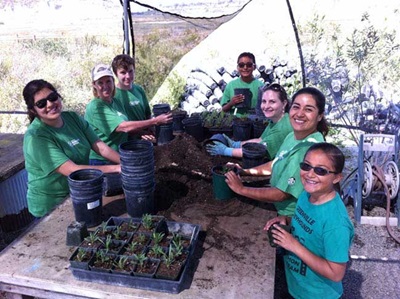
Climate Tools
The Natural Resources Agency utilizes a number of tools to support our climate action. Examples include:
California Climate Investments Quantification, Benefits, and Reporting Tools: this site provides links to a suite of tools used to measure the climate impacts of projects funded by California Climate Investments, including those managed by the Natural Resources Agency.
Priority Populations Mapping Tool: this tool allows users to identify priority populations based on several (but not all) definitions.
California’s Climate Data Tools: Cal-Adapt is a web-based platform that provides a view of how climate change might affect California. Cal-Adapt contains tools, data, and resources to conduct research, develop adaptation plans and build application.
California Heat Assessment Tool: The California Heat Assessment Tool (CHAT) was funded by the California Natural Resources Agency as part of the state's Fourth Climate Change Assessment. Four Twenty Seven, in partnership with Argos Analytics, Habitat Seven, and the Public Health Institute developed this tool for local and state health practitioners to better understand dimensions of heat vulnerability driven by climate changes and where action can be taken to mitigate the public health impacts of extreme heat in the future.
Sea the Future: This tool helps Californians understand sea level rise and flood visualization web tools that are available for their needs.
Climate Change and Health Vulnerability Indicators: These indicators were produced to better understand the people and places that are more susceptible to adverse health impacts associated with climate change.
Climate Resources
The State of California has a number of resources that support accelerated climate action. Examples include:
Adaptation Clearinghouse: this site provides users with a consolidated searchable database of California-specific resources for local, regional and statewide climate adaptation planning and decision-making.
Adaptation Planning Guide: CalOES works with state partners to regularly update this guide designed to support local government, regional organizations, and climate collaborative groups to integrate best practices and current science into their adaptation planning efforts.
Indicators of Climate Change in California: CalEPA researches and presents indicators in periodic reports describing how California’s climate is changing and how these changes are affecting the state. Indicators are scientifically-based measurements that track trends in various aspects of climate change.



